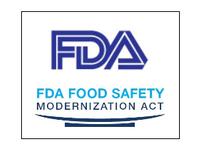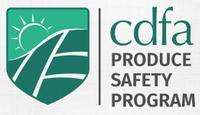Food Safety Modernization Act
Farmer Questionnaire
CDFA Produce Safety Program is requiring that ALL farms complete their questionnaire.
Please visit this page and complete the appropriate questionnaire to help CDFA make informed decisions about inspections, and to assist them in determining which farms may be exempt.
DEFINITIONS
FDA: United States Food & Drug Administration is the agency that created the law. California Department of Public Health and Sonoma County Department of Health Services are the regulators.
FSMA: Food Safety Modernization Act signed into law in 2011, they created the first ever food safety requirements for farms producing fruits and vegetables.
Produce Safety Rule (aka Produce Rule): Establishes science-based standards for growing, harvesting, packing, and holding produce. Food safety standards for farms to follow in an effort to reduce the risk of microbiological contamination that may occur during growing, harvesting, packing and holding fresh produce.
Preventive Controls Rule (aka Facility Rule): Requires that food facilities have safety plans that set forth how they will identify and minimize hazards. For facilities that manufacture, process, pack or hold food for human consumption.

|

Sign up for their newsletters to stay informed. |

|
Farm Activities vs Processing Activities
Allowable farm activities include:
- Packing and labeling raw agricultural products (RAC)
- Drying/dehydrating RAC (e.g. grapes to raisins) and packing and labeling such commodities
- Treatment to manipulate ripening of RAC (e.g. Ethylene) and packing and labeling such commodities
- Manufacturing/processing food (see Farming or Processing? next section)
- Secondary activities farm (not located on a primary production farm but provides farm services such as harvest, drying, hulling, etc)
Farming or Processing? (from NSAC PC Rule)
"Farms can engage in certain manufacturing/processing activities without falling outside the farm definition. However, most manufacturing/processing activities trigger the facility definition.
FDA defines “manufacturing/processing” to mean “making food from one or more ingredients, or synthesizing, preparing, treating, modifying or manipulating food, including food crops or ingredients.”
See: Additional Guidance on the FSMA Farm Definition: Farm vs Facility Activities on NSAC site.
Examples of manufacturing/processing activities, and the FSMA Rule associated, include:
|
|
Italicized activities are those that FDA has identified as being "manufacturing/processing activities that are part of the farm definition" and fall into the FSMA Produce Rule. [Code of Federal Regulations, Title 21 Food & Drugs, Part 1 General Enforcement Regulations, Subpart H Registration of Food Facilities Source, §1.226(b)(1)(iii)(B)(1)].
+Drying/dehydrating whole fruit only. Sliced and pitted require Cottage Food Operations or Processed Food Registration and if PFR, falls under FSMA Facility Rule.
*Harvesting: Examples of harvesting also include cooling, field coring, filtering, gathering, hulling, removing stems and husks from, shelling, sifting, threshing, trimming of outer leaves, and washing raw agricultural commodities grown on a farm.
Non-italicized activities are those that FDA identifies as processes that are outside of the farm definition and fall into the FSMA Facility Rule.
